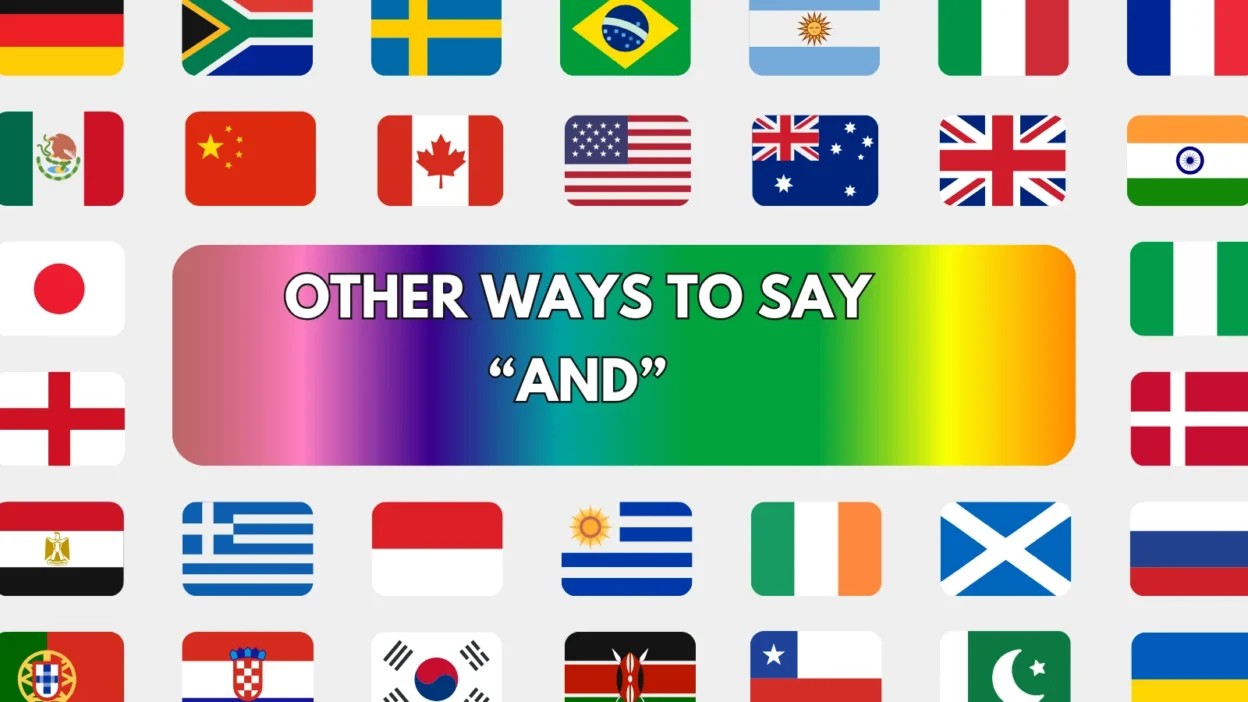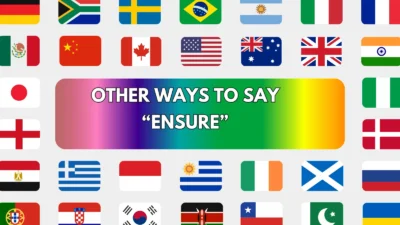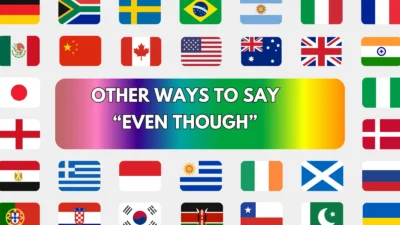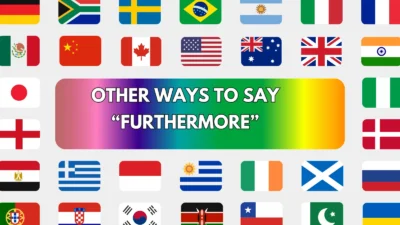The word “and” is one of the most commonly used connectors in the English language. It links ideas, phrases, and actions — but in writing and speech, repeating “and” too often can make your communication sound repetitive or overly simple.
This article provides 25 professional, creative, and context-appropriate alternatives to “and” that enhance clarity, variety, and tone — whether you’re writing an essay, crafting an email, or giving a speech.
1. As well as
Meaning:
Adds something in addition to what was previously mentioned.
Detailed Explanation:
This phrase is more formal and often emphasizes both items equally. It’s ideal for professional or academic writing.
Scenario Example:
She’s skilled in graphic design as well as digital marketing.
Best Use:
Resumes, business documents, academic papers.
Tone:
Professional, polished.
2. In addition
Meaning:
Introduces something extra or supplementary.
Detailed Explanation:
A slightly more formal alternative to “and” that’s perfect for structured writing and presentations.
Scenario Example:
In addition to increasing sales, the campaign improved brand awareness.
Best Use:
Essays, reports, formal communication.
Tone:
Formal, clear.
3. Plus
Meaning:
Adds something more in a casual way.
Detailed Explanation:
Less formal than “in addition” but very common in conversation or casual writing.
Scenario Example:
We’ll need chairs, tables, plus an extra tent in case it rains.
Best Use:
Conversations, emails, lists.
Tone:
Casual, friendly.
4. Along with
Meaning:
Adds something that accompanies another.
Detailed Explanation:
Often used when two items or people are doing something together or are included together.
Scenario Example:
The CEO attended the meeting along with the marketing team.
Best Use:
Professional writing, news, updates.
Tone:
Neutral, informative.
5. Also
Meaning:
Adds another point, idea, or item.
Detailed Explanation:
Very versatile — can be used at the beginning or middle of a sentence to add emphasis.
Scenario Example:
She speaks French. She also understands Italian.
Best Use:
Writing, speaking, general use.
Tone:
Neutral, versatile.
6. Moreover
Meaning:
Adds emphasis to a further point.
Detailed Explanation:
More formal and academic; used to strengthen an argument or add an important supporting idea.
Scenario Example:
The software is easy to use. Moreover, it saves time.
Best Use:
Essays, formal writing, arguments.
Tone:
Formal, persuasive.
7. Furthermore
Meaning:
Introduces an additional point with emphasis.
Detailed Explanation:
Similar to “moreover,” but with a slightly more academic tone.
Scenario Example:
The plan is cost-effective. Furthermore, it reduces environmental impact.
Best Use:
Academic or persuasive writing.
Tone:
Formal, logical.
8. Together with
Meaning:
Combines multiple people or elements.
Detailed Explanation:
Used when things are grouped or occur at the same time.
Scenario Example:
She submitted the report together with supporting documents.
Best Use:
Business writing, process descriptions.
Tone:
Professional, factual.
9. What’s more
Meaning:
Adds surprising or impressive information.
Detailed Explanation:
Used to build momentum in writing or speech, often to intensify a point.
Scenario Example:
He completed the project early. What’s more, he came under budget.
Best Use:
Persuasive writing, presentations.
Tone:
Enthusiastic, persuasive.
10. Not only that
Meaning:
Adds another surprising or supporting point.
Detailed Explanation:
Usually follows a strong statement to show there’s even more to support it.
Scenario Example:
She’s a top performer. Not only that, she mentors new employees.
Best Use:
Speaking, informal writing, motivation.
Tone:
Conversational, strong.
11. As well
Meaning:
Another way to say “too” or “also.”
Detailed Explanation:
Placed at the end of a sentence to add another item or idea.
Scenario Example:
He’s joining the dinner. I’ll be there as well.
Best Use:
Everyday speech, messages.
Tone:
Polite, natural.
12. In like manner
Meaning:
Adds a similar example or situation.
Detailed Explanation:
Often used to show that one thing happens just like another.
Scenario Example:
The first team improved their score. In like manner, the second team did the same.
Best Use:
Academic, descriptive writing.
Tone:
Formal, comparative.
13. Too
Meaning:
Indicates something additional.
Detailed Explanation:
Simple and familiar, used similarly to “also” or “as well.”
Scenario Example:
She enjoys hiking. He does, too.
Best Use:
Informal writing, conversations.
Tone:
Casual, clear.
14. Including
Meaning:
Specifies something added as part of a group.
Detailed Explanation:
Often used to highlight an item or person within a larger set.
Scenario Example:
Several employees, including the new hire, attended the workshop.
Best Use:
Business communication, detailed writing.
Tone:
Clear, factual.
15. Coupled with
Meaning:
Adds something that occurs together with another factor.
Detailed Explanation:
Common in cause-and-effect or descriptive writing.
Scenario Example:
High demand, coupled with limited supply, drove prices up.
Best Use:
Reports, analysis, formal contexts.
Tone:
Analytical, formal.
16. On top of that
Meaning:
Adds an additional point, usually one that strengthens your statement.
Detailed Explanation:
Informal, often used to emphasize frustration or good fortune.
Scenario Example:
We missed the flight, and on top of that, our luggage got lost.
Best Use:
Stories, casual speech, emphasis.
Tone:
Conversational, expressive.
17. As another point
Meaning:
Adds another idea in a structured way.
Detailed Explanation:
Formal and useful when listing ideas or arguments.
Scenario Example:
As another point, we should evaluate the competition’s strategy.
Best Use:
Debates, formal discussions.
Tone:
Organized, intellectual.
18. What else
Meaning:
Suggests continuation or addition.
Detailed Explanation:
Informal and rhetorical — used when casually listing multiple items.
Scenario Example:
We need food, drinks, decorations… what else?
Best Use:
Conversations, brainstorming.
Tone:
Casual, spontaneous.
19. Not to mention
Meaning:
Adds something important or impressive as an afterthought.
Detailed Explanation:
Shows there’s even more value or impact than previously mentioned.
Scenario Example:
The new phone has a great camera, not to mention longer battery life.
Best Use:
Promotional writing, persuasion.
Tone:
Persuasive, engaging.
20. And then
Meaning:
Adds a sequence or next action.
Detailed Explanation:
Often used in storytelling or to describe step-by-step processes.
Scenario Example:
We met for lunch, and then we went shopping.
Best Use:
Narratives, instructions.
Tone:
Sequential, casual.
21. Together
Meaning:
Shows that things are happening or being presented as a group.
Detailed Explanation:
Often emphasizes unity or joint action.
Scenario Example:
They developed the idea together during a late-night session.
Best Use:
Teamwork messages, relationship writing.
Tone:
Unified, friendly.
22. Next
Meaning:
Indicates an item that follows another.
Detailed Explanation:
Great for presentations or structured processes.
Scenario Example:
First, we’ll review the proposal. Next, we’ll open the floor to questions.
Best Use:
Public speaking, process explanations.
Tone:
Organized, neutral.
23. In the same way
Meaning:
Shows similarity between two actions or ideas.
Detailed Explanation:
Used to extend one idea to another with the same tone or result.
Scenario Example:
The sales team improved their efficiency. In the same way, customer service saw better performance.
Best Use:
Comparative writing, training materials.
Tone:
Formal, reflective.
24. Beyond that
Meaning:
Introduces something even more significant.
Detailed Explanation:
Adds a new level of importance or impact to what’s already said.
Scenario Example:
They cut costs. Beyond that, they increased profits by 20%.
Best Use:
Business writing, achievements.
Tone:
Professional, impactful.
25. Over and above that
Meaning:
Adds something even more than what’s expected.
Detailed Explanation:
Often used to show extra effort or unexpected benefits.
Scenario Example:
She completed the project early, over and above that, she improved the design.
Best Use:
Formal praise, recognition.
Tone:
Appreciative, impressive.
Conclusion
The word “and” might be small, but it carries big meaning in connecting ideas. By using these 25 thoughtful and diverse alternatives, you can add variety, improve flow, and adapt your tone to any setting — from academic essays to friendly messages.




